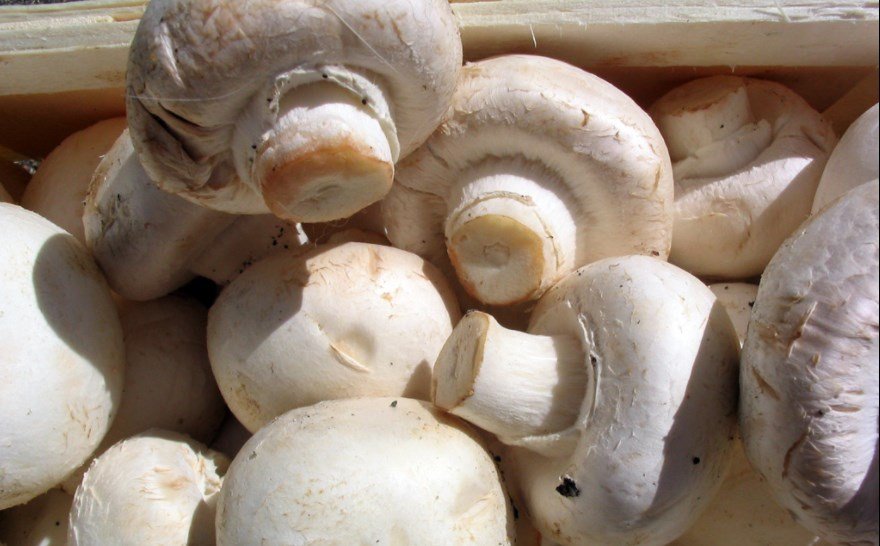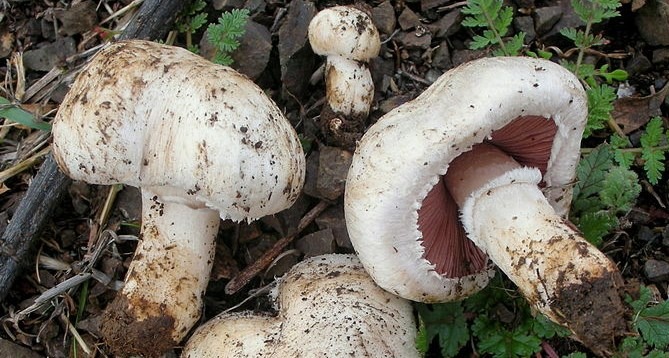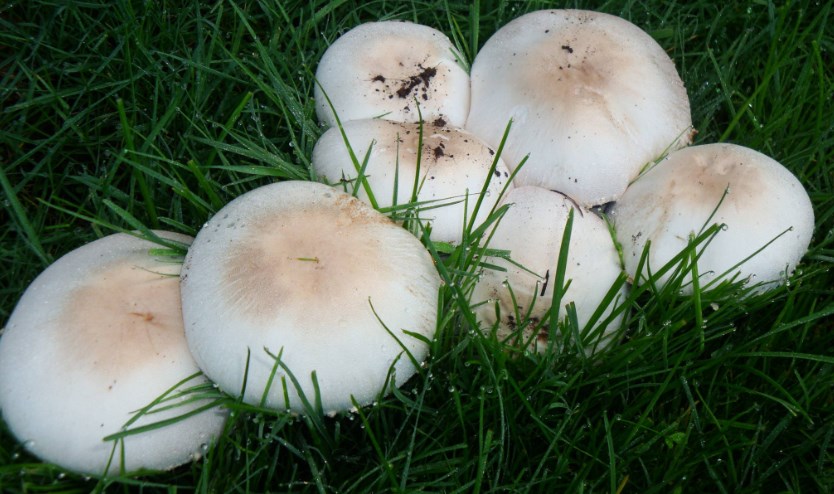The Agaricus bisporus is perhaps one of the most consumed mushrooms in the world. Commonly called Champignon Mushroom or Portobello Mushroom, it is an excellent edible mushroom, cultivated on a large scale in many countries, among which Poland, which is its main exporter.

Other names of the Agaricus Bisporus
Agaricus bisporus is called also as Portobello mushroom (and also as Portabella or portobella). In Italy is known mainly by the name of Champignon.
In the scientific literature, synonyms of Agaricus bisporus are Agaricus hortensis (Cooke) Pilát; Psaliota hortensis (Cooke) J.E. Lange; Psaliota bispora (J.E. Lange) F.H. Møller Jul. Schäff.
The name currently accepted is, however, Agaricus bisporus whose etymology from the Latin is “agaricus” = rural and “bisporus” = which generates two spores.
The genus Agaricus includes other edible species, such as Agaricus arvensis, the Agaricus campestris and Agaricus bitorquis, Agaricus augustus and Agaricus essettei.
The variety Avellanus (Portobello Mushroom)
The Portobello Mushroom, Agaricus Avellanus, is a variety of the bisporus, also very much used in the kitchen. It has hazelnut-coloured gills and an excellent savoury flavour. Its smell is similar to the aroma emanating from conifers.

Agaricus bisporus description
The cap of Agaricus bisporus is initially globular in the young specimens, which, growing up, open it up to be completely extended in the adult specimens.
The surface of the cap may be smooth or variously scaly, ivory-white to ochre in colour. In the specimens with scales, the scales have brownish tones.
The edge of the cap can often be membranous and floccose due to veil residues.
Stipe of Agaricus bisporus
The stipe of Agaricus bisporus is stocky and fleshy, with a cylindrical section and slightly bulbous at the base. At times, it may be hollow, and has a membranous ring, residual of the veil covering the hymenium in the young specimens.
Gills of Agaricus bisporus
The gills are thick and adherent to the stem, quite high and thin. The colour of the gills is usually pinkish in the young specimens, passing then through gradually darker shades during the ripening, from brown-cinnamon to sepia when ripe.
Flesh of Agaricus bisporus
The flesh is fairly firm in its youth, softer and softer as the growth progresses. When cut, it turns from white to a more or less evident red-pink. The smell and taste of the meat are not very significant, even if pleasant and with a slight acidic aftertaste.

Growth period
The growth period of Agaricus bisporus is generally extended throughout the year, depending on the location. The fungus does not grow in late winter and with too cold temperatures.
However, as it is one of the major species of mushrooms grown for food use, it can be found on the stalls of the vegetable grower or grocery store for the whole year.
Habitat of Agaricus bisporus
Like many other mushrooms belonging to the genus Agaricus, also the Champignon prefers to grow in well fertilized soils, dung, lawns and gardens.
Although it is a cultivated species, it is not frequent to find it in the natural environment. On the Atlantic side of Europe it often grows associated with plants of young Monterey cypresses because these plants are cultivated with manure from crops of Agaricus bisporus.
Cultivation of Agaricus bisporus
The cultivation of Agaricus bisporus originates in very ancient times.
Already in the 1st century A.D. these mushrooms were cultivated in caves, but the actual large-scale cultivation began in France in the second half of the 1600s.
It was discovered that a little horse manure and garden waste was enough to produce good mushrooms.
In a 1707 treatise the importance of good seeding with mycelium germinated by spores, manure and soil cover to be placed on top of the compound is explained.
The cultivation cycle of the Agaricus bisporus mushroom lasts 100/120 days and can therefore be repeated two or three times a year.
In Italy, cultivation began near Vicenza around 1913, and since 1950 it has developed with more modern production techniques.
Let’s see how the cultivation of the Agaricus bisporus works now!
Environment and Temperature for Cultivation
First of all, it is good to talk about the environment where we are going to grow them.
In ancient times, but even now, the cultivation in caves was preferred, because the temperature and especially the humidity must be carefully controlled.
The temperature for a correct development of Agaricus bisporus should never exceed 22-23°C and the air humidity should be between 80 and 100% (measurable with a hygrometer).
Substrate for mushrooms
The mushrooms are always found in stores or you can also grow at home with ready-made kits, the bales of mushrooms.
Alternatively, this is the procedure for manual cultivation:
The substrate on which we will grow the mushrooms must be carefully prepared with 1/3 of wheat straw (but it is also fine with oats or barley), 1/3 of peat and woodland and 1/3 of mature horse manure.
Alternatively, the substrate can be prepared by always mixing 1/3 of mature horse manure with 1/3 of blond peat and 1/3 of sandy soil.
Once the substrate has been created, it is placed in sacks or wooden boxes and watered. For 5-10 days a sort of fermentation will take place in the stratified mass of the substrate, which will act as a pasteurization.
Modern manufacturing companies in fact operate a real pasteurization with steam of the substrate, to eliminate fungi and bacteria antagonists.
Once the substrate is ready, we proceed to sprinkle the mycelia of Agaricus bisporus on our growing medium and cover it with wet peat, at least 4 or 5 cm. This phase is called incubation.
Watering little and often and keeping temperature and humidity always controlled, after about two weeks we cover the boxes or bags with a layer of soil in which the mycelium will grow and expand.
At a temperature of 17°C, the first carpophores should begin to develop after about ten days.
Recipes with mushrooms Agaricus bisporus
Agaricus bisporus is an edible mushroom also as raw, together with salads or alone in “carpaccio”, even if we remind you that it is good not to exceed with the consumption of raw mushrooms.
To prepare a carpaccio with Champignon, just choose the youngest specimens, cut them into thin slices and dress them with simple oil, salt and lemon and a pinch of pepper. Even a few flakes of parmesan cheese are not bad!
A fresh summer salad can be prepared with the addition of sliced mushrooms.
Agaricus bisporus is also suitable for cooking in various preparations.
An easy recipe for a tasty side dish involves browning the sliced Champignons for 15-20 minutes in a pan of hot oil with garlic and chilli. A little salt and freshly chopped parsley to finish this quick and easy side dish.
Baked Stuffed Agaricus bisporus Mushroom
For good baked stuffed Champignons, you must first remove the hat from the stem. The stem can be chopped with garlic, parsley, a little breadcrumbs and parmesan cheese. Those with a sweet tooth can add cubes of bacon or lard. With this mixture, the mushroom hats will be stuffed, a drizzle of oil and baked in the oven at 180°C for ten to fifteen minutes.
IDENTITY CARD
CAP COLOR: White – Brown
STIPE HEIGHT: 3-8 cm
STIPE COLOR: white
GILLS: Rosee
FLESH: White
SMELL: Strong
TASTE: Decided
SPORE: Brown Swiss
HABITAT: Farmland
Did you find what you were looking for? See also here:
- Ganoderma Lucidum
- Armillaria Mellea
- Amanita Caesarea
- Agaricus Bisporus
- Amanita Phalloides
- Coriolus Versicolor
- Flammulin Velutipes
- Marasmius Oreades
- Pleurotus Ostreatus
- Agaricus Campestris
- Macrolepiota procera